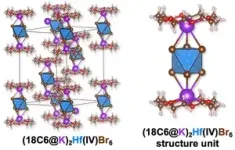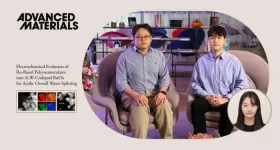A new 3D-printable material called “supramolecular ink” replaces costly scarce metals with inexpensive, Earth-abundant materials. The organic material requires far less energy to manufacture than conventional methods. It could also enhance the sustainability of 3D-printable wearable devices, lighting technologies, and luminescent art and sculpture. A research team led by Lawrence Berkeley National Laboratory (Berkeley Lab) has developed “supramolecular ink,” a new technology for use in OLED (organic light-emitting diode) displays or other electronic devices. Made of inexpensive, Earth-abundant elements instead of costly scarce metals, supramolecular ink could enable more affordable and environmentally sustainable flat-panel screens and electronic devices.
“By replacing precious metals with Earth-abundant materials, our supramolecular ink technology could be a game changer for the OLED display industry,” said principal investigator Peidong Yang, a faculty senior scientist in Berkeley Lab’s Materials Sciences Division and professor of chemistry and materials science and engineering at UC Berkeley. “What’s even more exciting is that the technology could also extend its reach to organic printable films for the fabrication of wearable devices as well as luminescent art and sculpture,” he added.
If you have a relatively new smartphone or flat panel TV, there’s a good chance it features an OLED screen. OLEDs are rapidly expanding in the display market because they are lighter, thinner, use less energy, and have better picture quality than other flat-panel technologies. That’s because OLEDs contain tiny organic molecules that emit light directly, eliminating the need for the extra backlight layer that is found in a liquid crystal display (LCD). However, OLEDs can include rare, expensive metals like iridium.
But with the new material – which the Berkeley Lab team recently described in a new study published in the journal Science – electronics display manufacturers could potentially adopt a cheaper fabrication process that also requires far less energy than conventional methods.
The new material consists of powders containing hafnium (Hf) and zirconium (Zr) that can be mixed in solution at low temperatures – from room temperature up to around 176 degrees Fahrenheit (80 degrees Celsius) – to form a semiconductor “ink.”
Tiny molecular “building block” structures within the ink self-assemble in solution – a process that the researchers call supramolecular assembly. “Our approach can be compared to building with LEGO blocks,” said Cheng Zhu, the co-first author on the paper and a Ph.D. candidate in materials science and engineering at UC Berkeley. These supramolecular structures enable the material to achieve stable and high-purity synthesis at low temperatures, explained Zhu. He developed the material while working as a research affiliate in Berkeley Lab’s Materials Sciences Division and graduate student researcher in the Peidong Yang group at Berkeley Lab and UC Berkeley.
Spectroscopy experiments at UC Berkeley revealed that the supramolecular ink composites are highly efficient emitters of blue and green light – two signifiers of the material’s potential application as an energy-efficient OLED emitter in electronic displays and 3D printing.
Subsequent optical experiments revealed that the blue- and green-emitting supramolecular ink compounds exhibit what scientists call near-unity quantum efficiency. “This demonstrates their exceptional ability to convert nearly all absorbed light into visible light during the emission process,” Zhu explained.
To demonstrate the material’s color tunability and luminescence as an OLED emitter, the researchers fabricated a thin-film display prototype from the composite ink. In an exciting result, they found that the material is suitable for programmable electronic displays.
“The alphabet movie serves as a compelling example that illustrates the application of emissive thin films like supramolecular ink in the creation of fast-switching displays,” said Zhu.
Additional experiments at UC Berkeley showed that the supramolecular ink is also compatible with 3D printing technologies such as for the design of decorative OLED lighting.
Zhu added that manufacturers could also use the supramolecular ink to fabricate wearable devices or high-tech clothing that illuminates for safety in low-light conditions, or wearable devices that display information through the supramolecular light-emitting structures.
The supramolecular ink is another demonstration from the Peidong Yang lab of new sustainable materials that could enable cost-effective and energy-efficient semiconductor manufacturing. Last year, Yang and his team reported a new “multielement ink” – the first “high-entropy” semiconductor that can be processed at low temperature or room temperature.
With their demonstrated stability and shelf life, the supramolecular ink compounds could also help in the commercial advancement of ionic halide perovskites, a thin-film solar material that the display industry has been eyeing for decades. With their low-temperature synthesis in solution, ionic halide perovskites could potentially enable cheaper manufacturing processes for the manufacturing of displays. But high-performance halide perovskites contain the element lead, which is concerning for the environment and public health. In contrast, the new supramolecular ink – which belongs to the ionic halide perovskite family – offers a lead-free formulation without compromising performance.
Now that they have successfully demonstrated the supramolecular ink’s potential in OLED thin films and 3D-printable electronics, the researchers are now exploring the material’s electroluminescent potential. “This involves a focused and specialized investigation into how well our materials can emit light using electrical excitation,” Zhu said. “This step is essential to understanding our material’s full potential for creating efficient light-emitting devices.”
Other authors on the study include Jianbo Jin (co-first author), Zhen Wang, Zhenpeng Xu, Maria C. Folgueras, Yuxin Jiang, Can B. Uzundal, Han K.D. Le, Feng Wang, and Xiaoyu (Rayne) Zheng.
This work was supported by the Department of Energy’s Office of Science.
The technology is available for licensing or collaborative research through Berkeley Lab’s Intellectual Property Office. Contact ipo@lbl.gov for more information.
###
Lawrence Berkeley National Laboratory (Berkeley Lab) is committed to delivering solutions for humankind through research in clean energy, a healthy planet, and discovery science. Founded in 1931 on the belief that the biggest problems are best addressed by teams, Berkeley Lab and its scientists have been recognized with 16 Nobel Prizes. Researchers from around the world rely on the Lab’s world-class scientific facilities for their own pioneering research. Berkeley Lab is a multiprogram national laboratory managed by the University of California for the U.S. Department of Energy’s Office of Science.
DOE’s Office of Science is the single largest supporter of basic research in the physical sciences in the United States, and is working to address some of the most pressing challenges of our time. For more information, please visit energy.gov/science.
END







